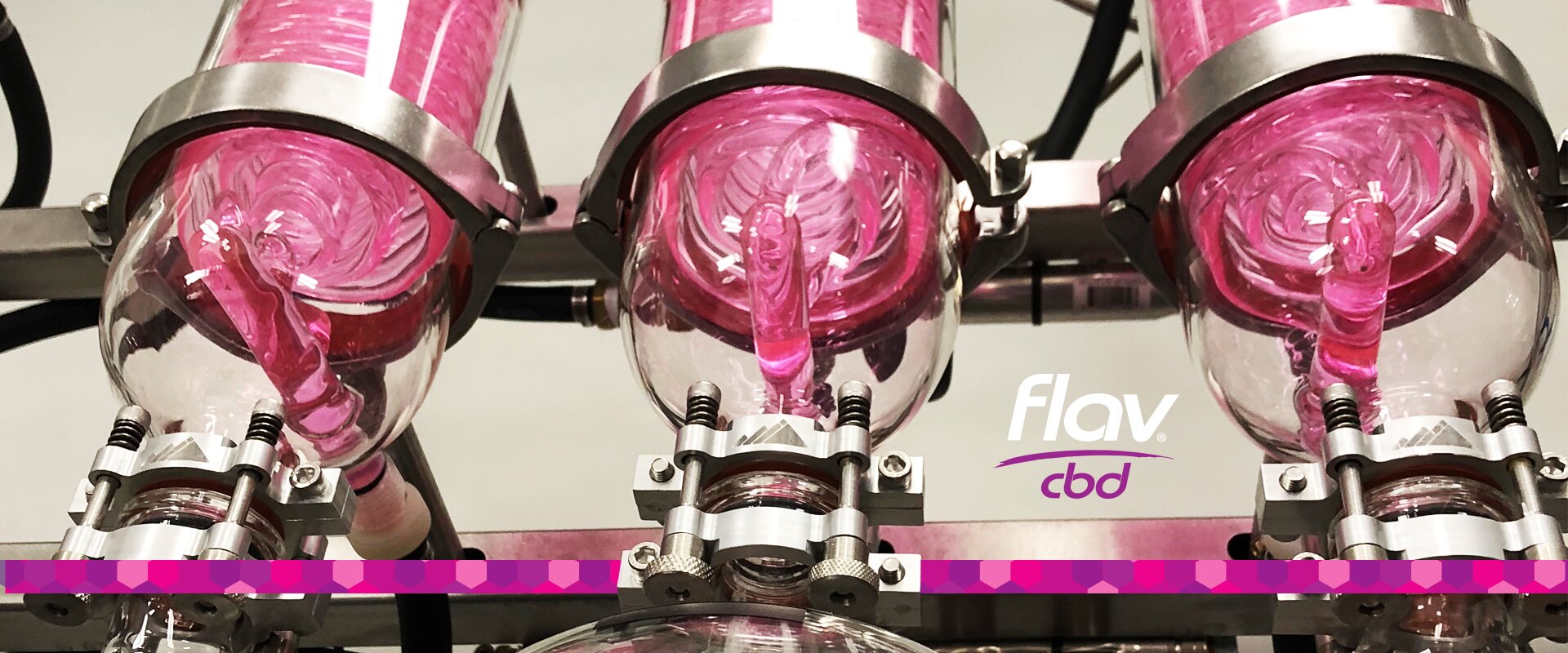
To produce the industry’s purest and most potent broad spectrum CBD oil, Flav starts with 100% organic lab-tested cannabis that’s certified to be of the highest quality grown. All of our plants are grown without pesticides, artificial fertilizers, or any other chemicals. Our broad spectrum CBD oils preserve the complete cannabinoid and terpene contents of the raw plant to magnify the therapeutic benefits of the plant’s individual components in what’s referred to as the Entourage Effect.
To achieve this level of quality, Flav uses supercritical carbon dioxide (CO2) extraction — the most expensive and effective extraction process available. We selected CO2 extraction because it produces the most consistent, pure, and potent CBD oils available. The extraction process uses carbon dioxide under intense pressure and extremely low temperatures — acting like a solvent — to isolate and separate the desirable compounds of the cannabis plant. Throughout each step of the manufacturing process, all of our products are examined at our certified testing labs for purity, potency, and quality.
Flav is in compliance with all applicable federal and state laws and regulations to ensure the highest quality and safest CBD products available.
HOW FLAV MAINTAINS COMPLIANCE WITH FEDERAL & STATE LAWS
Federal law continues to evolve concerning CBD products and many states have strict laws that regulate the purity and safety of cannabis products. Flav maintains a rigorous schedule of testing to ensure our CBD products meet and exceed state and federal standards.
Many states require that all cannabis products be tracked from seed to sale. To maintain compliance with these laws, Flav only uses cannabis products that can be traced back to their source. Every Flav product comes with a QR code that can connect you to a certified laboratory test result for that product.

LAWS THAT FLAV COMPLIES WITH
The Agricultural Act of 2014
Section 7606 of the Agricultural Act of 2014, commonly referred to as the Farm Bill, regulates cannabis cultivation and research. Section 7606, titled “Legitimacy of Industrial Hemp Research,” regulates the cultivation and processing of hemp and hemp-derived products. Section 7606 has two conditions which must be met for the growth of hemp to be legal under federal law:
1. “The industrial hemp is grown or cultivated for purposes of research conducted under an agricultural pilot program or other agricultural or academic research; and
2. The growing or cultivating of industrial hemp is allowed under the laws of the State in which such institution of higher education or State department of agriculture is located and such research occurs.”
The Farm Bill does make an exception to the legal definition of marijuana as it relates to industrial hemp. Industrial hemp is defined as, “the plant Cannabis sativa L. and any part of such plant, whether growing or not, with a [THC] concentration of not more than 0.3 percent on a dry weight basis.” This means that any cannabis with less than 0.3% THC by weight is not considered a controlled substance by the federal government.
The Controlled Substances Act of 1970
This drug policy allows the federal government to determine what substances constitute a risk to public health and to regulate them appropriately. Marijuana is a Schedule 1 controlled substance. This means that the federal government considers marijuana to have “no currently accepted medical use and a high potential for abuse.” Under the Schedule 1 designation for marijuana, THC is described as the component responsible for marijuana’s classification as a controlled substance. However, cannabis containing 0.3% or less THC by volume is not considered by the Drug Enforcement Administration (DEA) to be a controlled substance. In May of 2018, the DEA reiterated that “the mere presence of cannabinoids” does not constitute a controlled substance.
Consolidated Appropriations Act, 2016
Section 763 of the Consolidated Appropriations Act, 2016, commonly referred to as the Omnibus Appropriations Act, determined how federal money can be used in marijuana law enforcement. Section 763 of the 2016 funding bill prohibits the federal government from spending federal dollars “to prohibit the transportation, processing, sale, or use of industrial hemp that is grown or cultivated in accordance with Section 7606 of the Agricultural Act of 2014, within or outside the State in which the industrial hemp is grown or cultivated.”
This effectively prohibits the federal government from spending any federal funds to prosecute individuals involved in any cannabis-related activities under the regulation of Section 7606 of the Agricultural Act of 2014.
THE LEGAL DIFFERENCE BETWEEN HEMP & CANNABIS
The federal government considers a cannabis plant to be hemp when it contains 0.3% or less THC by volume.
GENERAL INFORMATION ABOUT CANNABIS
While slightly controversial, it is still generally accepted that there are three species of cannabis: Indica, Sativa, and Ruderalis. Indica grows short in stature with broad leaves. It is known for having sedating and relaxing effects on the body. Some forms of Indica are selectively bred to have very low THC content so they can be classified as hemp to produce CBD products. Sativa grows tall in stature with thin leaves. It is known for having uplifting, mostly cerebral effects. Ruderalis is a short and stalky variety that produces almost no flowering tops. Indica and Sativa species are both widely used for cannabis products.
The statements regarding these products have not been evaluated by the Food and Drug Administration.These products are not intended to diagnose, treat, cure, or prevent any disease. Results from products may vary.

